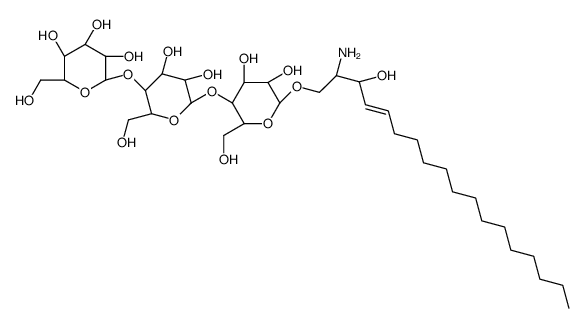Lyso-Globotriaosylceramide (d18:1)

Lyso-Globotriaosylceramide (d18:1) structure
|
Common Name | Lyso-Globotriaosylceramide (d18:1) | ||
|---|---|---|---|---|
| CAS Number | 126550-86-5 | Molecular Weight | 785.91400 | |
| Density | 1.37g/cm3 | Boiling Point | 1005.8ºC at 760 mmHg | |
| Molecular Formula | C36H67NO17 | Melting Point | N/A | |
| MSDS | USA | Flash Point | 562.1ºC | |
|
LC–MS/MS analysis of plasma lyso-Gb3 in Fabry disease
Clin. Chim. Acta 414 , 273-80, (2012) Background Fabry disease is a complex, multisystemic and clinically heterogeneous disease, with elevated excretion of globotriaosylceramide (Gb3) and globotriaosylsphingosine (lyso-Gb3) accumulating in biological fluids caused by deficiency of the enzyme, lys... |
|
|
A metabolomic study reveals novel plasma lyso-Gb3 analogs as Fabry disease biomarkers.
Curr. Med. Chem. 20(2) , 280-8, (2013) Fabry disease is an X-linked, multisystemic lysosomal storage disorder due to alpha-galactosidase A deficiency. It is characterized by the accumulation of glycosphingolipids, mainly globotriaosylceramide (Gb(3)), in biological fluids, vascular endothelium, he... |
|
|
In vivo tumor targeting using a novel intestinal pathogen-based delivery approach.
Cancer Res. 66(14) , 7230-6, (2006) Efficient methods for tumor targeting are eagerly awaited and must satisfy several challenges: molecular specificity, transport through physiologic barriers, and capacity to withstand extracellular or intracellular degradation and inactivation by the immune s... |
|
|
Plasma globotriaosylsphingosine as a biomarker of Fabry disease.
Mol. Genet. Metab. 100(3) , 257-61, (2010) Fabry disease is an X-linked genetic disorder caused by a deficiency of alpha-galactosidase A (GLA) activity. As enzyme replacement therapy (ERT) involving recombinant GLAs has been introduced for this disease, a useful biomarker for diagnosis and monitoring ... |
|
|
Quantification of the Fabry marker lysoGb3 in human plasma by tandem mass spectrometry.
J. Chromatogr. B. Analyt. Technol. Biomed. Life Sci. 883-884 , 128-35, (2012) Morbus Fabry is a hereditary metabolic disorder with low prevalence and late clinical manifestation. A defect in the α-galactosidase gene leads to lysosomal accumulation of the glycolipid globotriaosylceramide (Gb3). Gb3 may be used for monitoring of enzyme r... |
|
|
Induction of cytokines by toxins that have an identical RNA N-glycosidase activity: Shiga toxin, ricin, and modeccin.
Biochim. Biophys. Acta 1671(1-3) , 44-50, (2004) Shiga toxin (Stx) has an A1-B5 subunit structure, and the A subunit is an RNA N-glycosidase that inhibits cellular protein synthesis. We previously reported that in Caco-2 cells Stx induced cytokines and that the RNA N-glycosidase activity was essential for t... |
|
|
Binding ofSilurus asotuslectin to Gb3 on Raji cells causes disappearance of membrane-bound form of HSP70
Biochim. Biophys. Acta 1790(2) , 101-9, (2009) Heat shock proteins (HSPs) are divided into stress-inducible and constitutive types. Generally, HSP70 (stress inducible) and HSC70 (constitutive) are representative of their types, respectively. From the results of immunocytochemical analysis, both HSP70 and ... |
|
|
Tissue and plasma globotriaosylsphingosine could be a biomarker for assessing enzyme replacement therapy for Fabry disease.
Biochem. Biophys. Res. Commun. 399(4) , 716-20, (2010) Fabry disease is a genetic disease caused by a deficiency of alpha-galactosidase A (GLA), which leads to systemic accumulation of glycolipids, predominantly globotriaosylceramide (Gb3). With the introduction and spread of enzyme replacement therapy (ERT) with... |
|
|
Synthesis and properties of a mitochondrial peripheral benzodiazepine receptor conjugate.
ChemMedChem 3(11) , 1687-95, (2008) Peripheral benzodiazepine receptors are potential targets for cancer therapeutics through the use of specific ligands such as the pro-apoptotic benzodiazepine RO5-4864. However, the poor water solubility of this compound has been a limitation to its applicati... |
|
|
Early cerebral manifestations in a young female with Fabry disease with skewed X-inactivation.
Clin. Genet. 80(5) , 500-2, (2011)
|